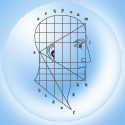 How do you measure the
length of a nose? Many people would just say, "I can tell a long nose
when I see one." There are different methods of assessing nasal
length, and I'll give you a feel of what I look for. Compare the
black and white diagrams above with the color pictures at the top of this page
as you read.
How do you measure the
length of a nose? Many people would just say, "I can tell a long nose
when I see one." There are different methods of assessing nasal
length, and I'll give you a feel of what I look for. Compare the
black and white diagrams above with the color pictures at the top of this page
as you read.
In a previous
chapter we discussed the concept of the "tip defining point," the
place along the profile where the exact position of the tip of the nose seems to
reside. In the after picture above right it's a little easier to find the
tip defining point than it is to find that spot on the before picture. I
have placed light blue arrows at the tip defining points.
We perceive the
length of the nose as the distance from where the nose begins, between the
eyes (white arrows),
down to where our eye thinks the nose ends, typically at the tip defining
point (light blue arrows).
The
red arrows, spanning the distance from the white arrow to the blue arrow, show the apparent length of this nose before and after surgery.
We can also see the apparent length of the nose in the length of the dark blue lines,
which follow the profile contour from the beginning of the nose at the eyes down
to the tip defining points.
|
















